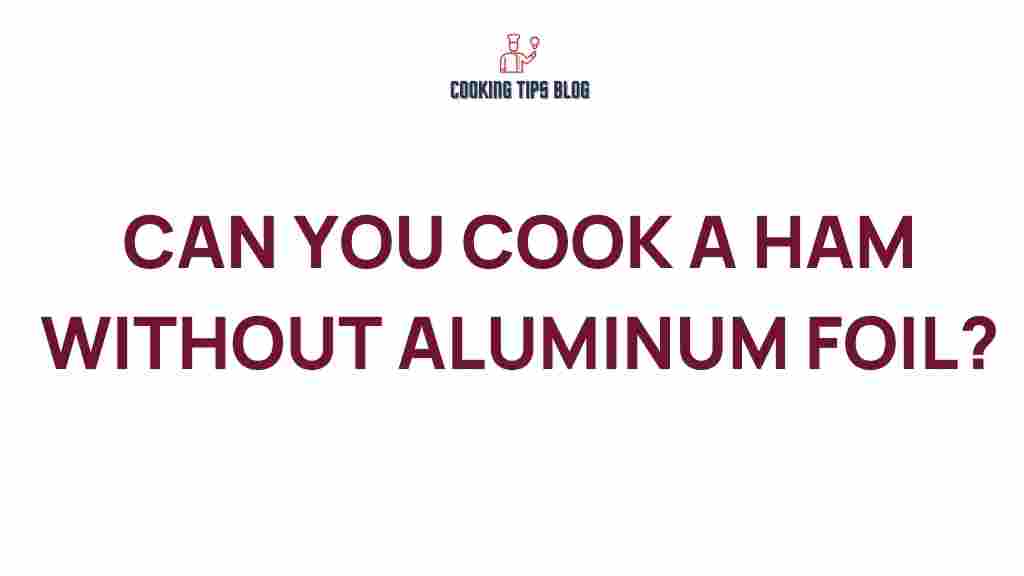The Surprising Truth: Cooking Ham Without Aluminum Foil
When it comes to holiday meals or special occasions, cooking ham is often the centerpiece of the feast. Traditionally, many people rely on aluminum foil to keep their ham moist and flavorful during the cooking process. However, have you ever wondered if you can cook a ham without aluminum foil? The answer may surprise you! In this article, we will explore various methods for cooking ham without aluminum foil, ensuring a delicious and juicy result every time.
Why Cook Ham Without Aluminum Foil?
Using aluminum foil can be convenient, but it’s not the only way to achieve a perfectly cooked ham. There are several reasons you might want to consider cooking ham without aluminum foil:
- Flavor Enhancement: Cooking ham uncovered allows for better caramelization of the sugars in the glaze, enhancing the overall flavor.
- Crispy Exterior: Without foil, the surface of the ham can become beautifully browned and crispy, adding a delightful texture.
- Health Considerations: Some people prefer to avoid aluminum foil due to concerns about potential health risks.
Preparing Your Ham for Cooking
Before diving into the cooking methods, let’s prepare your ham properly. Here’s a step-by-step guide to ensure you’re ready to cook your ham without aluminum foil:
Choosing the Right Ham
Not all hams are created equal. Consider the following when selecting your ham:
- Type: Decide between bone-in, boneless, or spiral-cut hams. Each type has its cooking method.
- Size: Ensure you choose a ham that fits your cooking vessel.
- Quality: Opt for a high-quality ham for the best flavor.
Essential Ingredients
You’ll need a few basic ingredients to achieve the perfect glaze:
- Brown sugar
- Honey or maple syrup
- Dijon mustard
- Spices (cinnamon, cloves, etc.)
- Liquid (apple juice, broth, or wine)
Step-by-Step Process: Cooking Ham Without Aluminum Foil
Now that you have everything prepared, let’s explore the methods for cooking ham without aluminum foil:
Oven Method
Cooking ham in the oven without foil is one of the most popular methods. Here’s how you can do it:
- Preheat Your Oven: Preheat your oven to 325°F (165°C).
- Prepare the Ham: Score the surface of the ham in a diamond pattern. This helps the glaze penetrate the meat.
- Make the Glaze: In a small saucepan, combine brown sugar, honey, Dijon mustard, and your choice of spices. Heat until dissolved.
- Place the Ham in the Oven: Put the ham on a rack in a roasting pan. Pour some liquid into the bottom of the pan to keep it moist.
- Apply the Glaze: Brush the glaze over the ham, ensuring it seeps into the scored cuts.
- Cook: Bake the ham for about 15-18 minutes per pound, basting every 30 minutes with the pan juices.
- Check Doneness: The internal temperature should reach 140°F (60°C) for pre-cooked ham or 160°F (71°C) for raw ham.
- Rest and Serve: Let the ham rest for 15-20 minutes before carving.
Slow Cooker Method
If you prefer a hands-off approach, consider using a slow cooker:
- Prepare the Ham: Score the surface and apply your glaze as mentioned earlier.
- Place in Slow Cooker: Put the ham in the slow cooker, adding some liquid to the bottom.
- Cook: Set the slow cooker on low and cook for 6-8 hours, or until heated through and tender.
- Finish with a Glaze: In the last hour of cooking, brush more glaze over the ham for added flavor.
Grilling Method
For a unique flavor, consider grilling your ham:
- Prepare the Grill: Preheat your grill to medium heat.
- Prepare the Ham: Score and glaze the ham as previously described.
- Wrap in Parchment Paper: Instead of foil, use parchment paper to help retain moisture.
- Grill: Place the ham on the grill, indirect heat, and cook for about 1-2 hours, basting occasionally.
Troubleshooting Tips for Cooking Ham
Even when cooking ham without aluminum foil, you may face some challenges. Here are tips to troubleshoot common problems:
Dry Ham
If your ham turns out dry, consider these fixes for next time:
- Ensure you baste the ham regularly.
- Add more liquid to the roasting pan or slow cooker.
- Cook at a lower temperature to allow for slower, juicier cooking.
Uneven Cooking
To avoid uneven cooking:
- Use a meat thermometer to monitor the internal temperature.
- Rotate the ham in the oven or grill to ensure even exposure to heat.
Burnt Glaze
If your glaze burns, try these adjustments:
- Apply the glaze later in the cooking process.
- Cover the ham loosely with parchment paper if it starts to darken too quickly.
Conclusion
Cooking ham without aluminum foil is not only possible but can also yield a more flavorful and enjoyable dish. With various methods available, such as oven roasting, slow cooking, and grilling, you can choose the one that best fits your preferences and occasion. Remember to choose a high-quality ham, prepare a delicious glaze, and follow the steps outlined in this article for a perfectly cooked ham that will impress your guests.
For more tips and tricks on cooking, check out our cooking guide. And remember, whether you’re preparing for a holiday feast or a simple family dinner, cooking ham without aluminum foil can enhance your culinary experience and create lasting memories.
For further reading on cooking techniques, visit this external resource for additional insights and recipes.
This article is in the category Tools and created by Cookingtipsblog Team
